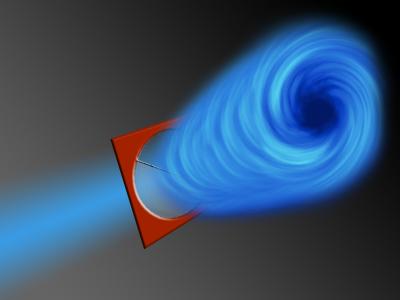Nov 6 2012
Nowadays, electron microscopes are an essential tool, especially in the field of materials science. At TU Vienna, electron beams are being created that possess an inner rotation, similarly to a tornado. These "vortex beams" cannot only be used to display objects, but to investigate material-specific properties - with precision on a nanometer scale. A new breakthrough in research now allows scientists to produce much more intense vortex beams than ever before.
 The electron beam passes through a screen and is transformed into a vortex beam. Credit: Vienna University of Technology
The electron beam passes through a screen and is transformed into a vortex beam. Credit: Vienna University of Technology
Quantum Tornado: the Electron as a Wave
In a tornado, the individual air particles do not necessarily rotate on their own axis, but the air suction overall creates a powerful rotation. The rotating electron beams that have been generated at TU Vienna behave in a very similar manner. In order to understand them, we should not think of electrons simply as minuscule points or pellets, as in that case they could at most rotate on their own axis. Vortex beams, on the other hand, can only be explained in terms of quantum physics: the electrons behave like a wave, and this quantum wave can rotate like a tornado or a water current behind a ship's propeller.
"After the vortex beam gains angular momentum, it can also transfer this angular momentum to the object that it encounters", explained Prof. Peter Schattschneider from the Institute of Solid State Physics at TU Vienna. The angular momentum of the electrons in a solid object is closely linked to its magnetic properties. For materials science it is therefore a huge advantage to be able to make statements regarding angular momentum conditions based on these new electron beams.
Beams Rotate - With Masks and Screens
Peter Schattschneider and Michael Stöger-Pollach (USTEM, TU Vienna) have been working together with a research group from Antwerp on creating the most intense, clean and controllable vortex beams possible in a transmission electron microscope. The first successes were achieved two years ago: at the time, the electron beam was shot through a minuscule grid mask, whereby it split into three partial beams: one turning right, one turning left and one beam that did not rotate.
Now, a new, much more powerful method has been developed: researchers use a screen, half of which is covered by a layer of silicon nitride. This layer is so thin that the electrons can penetrate it with hardly any absorption, however they can be suitably phase-shifted. "After focusing using a specially adapted astigmatic lens, an individual vortex beam is obtained", explained Michael Stöger-Pollach.
This beam is more intense by one order of magnitude than the vortex beams that we have been able to create to date. "Firstly, we do not split the beam into three parts, as is the case with a grid mask, but rather, the entire electron stream is set into rotation. Secondly, the grid mask had the disadvantage of blocking half of the electrons - the new special screen does not do this", said Stöger-Pollach.
Thanks to the new technology, right and left-rotating beams can now be distinguished in a reliable manner - previously this was only possible with difficulty. If we now add a predetermined angular momentum to each right and left-rotating beam, the rotation of one beam is increased, while the rotation of the other beam decreases.
Electron microscopes with a twist
This new technology was briefly presented by the research team in the "Physical Review Letters" journal. In future, the aim is to apply the method in materials science. Magnetic properties are often the focus of attention, particularly in the case of newly developed designer materials. "A transmission electron microscope with vortex beams would allow us to investigate these properties with nanometric precision", explained Peter Schattschneider.
More exotic applications of vortex beams are also conceivable: in principle, it is possible to set all kinds of objects in rotation - even individual molecules - using these beams, which possess angular momentum. Vortex beams could therefore also open new doors in nanotechnology.